6.小额贷款公司贷款五级分类实施细则(The detailed rules for the implementation of the five level clas
- 格式:doc
- 大小:67.50 KB
- 文档页数:23
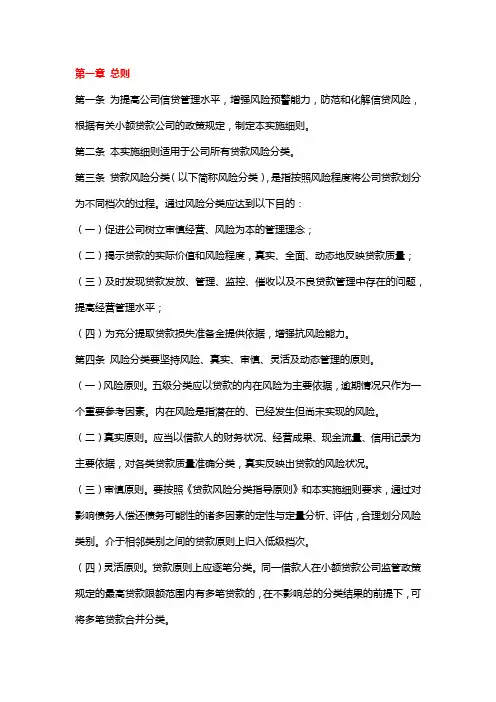
第一章总则第一条为提高公司信贷管理水平,增强风险预警能力,防范和化解信贷风险,根据有关小额贷款公司的政策规定,制定本实施细则。
第二条本实施细则适用于公司所有贷款风险分类。
第三条贷款风险分类(以下简称风险分类),是指按照风险程度将公司贷款划分为不同档次的过程。
通过风险分类应达到以下目的:(一)促进公司树立审慎经营、风险为本的管理理念;(二)揭示贷款的实际价值和风险程度,真实、全面、动态地反映贷款质量;(三)及时发现贷款发放、管理、监控、催收以及不良贷款管理中存在的问题,提高经营管理水平;(四)为充分提取贷款损失准备金提供依据,增强抗风险能力。
第四条风险分类要坚持风险、真实、审慎、灵活及动态管理的原则。
(一)风险原则。
五级分类应以贷款的内在风险为主要依据,逾期情况只作为一个重要参考因素。
内在风险是指潜在的、已经发生但尚未实现的风险。
(二)真实原则。
应当以借款人的财务状况、经营成果、现金流量、信用记录为主要依据,对各类贷款质量准确分类,真实反映出贷款的风险状况。
(三)审慎原则。
要按照《贷款风险分类指导原则》和本实施细则要求,通过对影响债务人偿还债务可能性的诸多因素的定性与定量分析、评估,合理划分风险类别。
介于相邻类别之间的贷款原则上归入低级档次。
(四)灵活原则。
贷款原则上应逐笔分类。
同一借款人在小额贷款公司监管政策规定的最高贷款限额范围内有多笔贷款的,在不影响总的分类结果的前提下,可将多笔贷款合并分类。
(五)动态管理原则。
公司贷款多为短期(不超过1年),原则上1—2个月必须进行一次贷后检查,在此基础上进行贷款分类,及时、动态地掌握影响贷款回收相关因素的变化情况,对风险状况已发生重大变化的应及时重新认定。
第五条对贷款进行风险分类应按户分析,根据借款人的整体还款可能性揭示贷款风险,并以评估借款人的还款能力为核心,把借款人的正常业务经营收入作为贷款的主要还款来源,贷款的担保作为次要还款来源。
第二章核心定义第六条评估公司贷款质量,采用以风险为基础的分类方法,按照按时、足额收回的可能性将贷款分为正常、关注、次级、可疑和损失五个类别,其中,后三类合称为不良贷款。
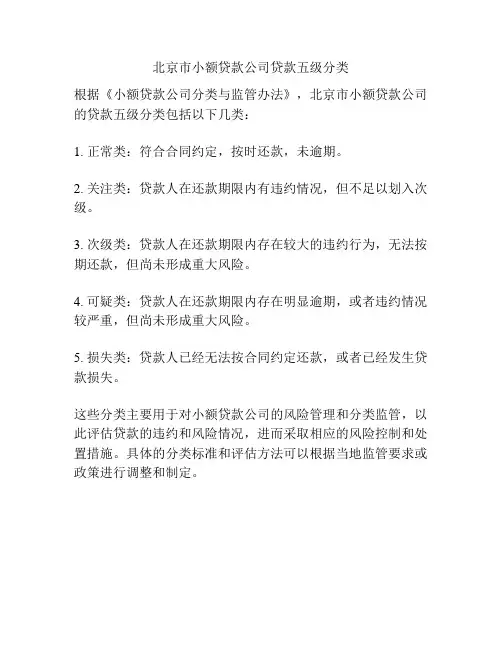
北京市小额贷款公司贷款五级分类
根据《小额贷款公司分类与监管办法》,北京市小额贷款公司的贷款五级分类包括以下几类:
1. 正常类:符合合同约定,按时还款,未逾期。
2. 关注类:贷款人在还款期限内有违约情况,但不足以划入次级。
3. 次级类:贷款人在还款期限内存在较大的违约行为,无法按期还款,但尚未形成重大风险。
4. 可疑类:贷款人在还款期限内存在明显逾期,或者违约情况较严重,但尚未形成重大风险。
5. 损失类:贷款人已经无法按合同约定还款,或者已经发生贷款损失。
这些分类主要用于对小额贷款公司的风险管理和分类监管,以此评估贷款的违约和风险情况,进而采取相应的风险控制和处置措施。
具体的分类标准和评估方法可以根据当地监管要求或政策进行调整和制定。
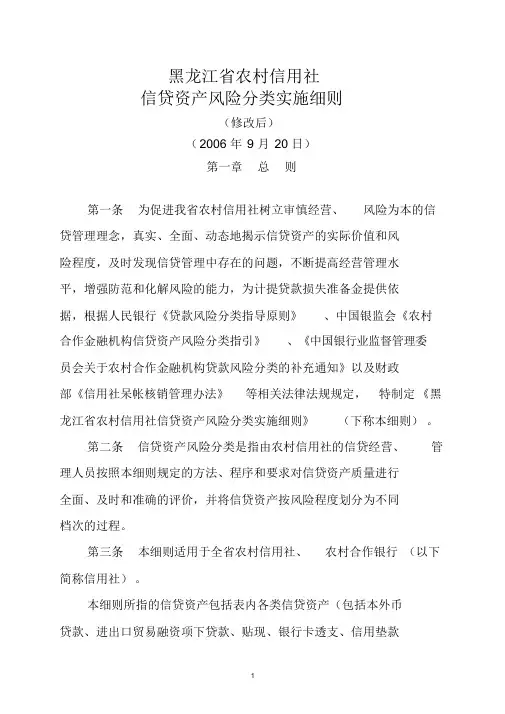
黑龙江省农村信用社信贷资产风险分类实施细则(修改后)(2006 年9 月20 日)第一章总则第一条为促进我省农村信用社树立审慎经营、风险为本的信贷管理理念,真实、全面、动态地揭示信贷资产的实际价值和风险程度,及时发现信贷管理中存在的问题,不断提高经营管理水平,增强防范和化解风险的能力,为计提贷款损失准备金提供依据,根据人民银行《贷款风险分类指导原则》、中国银监会《农村合作金融机构信贷资产风险分类指引》、《中国银行业监督管理委员会关于农村合作金融机构贷款风险分类的补充通知》以及财政部《信用社呆帐核销管理办法》等相关法律法规规定,特制定《黑龙江省农村信用社信贷资产风险分类实施细则》(下称本细则)。
第二条信贷资产风险分类是指由农村信用社的信贷经营、管理人员按照本细则规定的方法、程序和要求对信贷资产质量进行全面、及时和准确的评价,并将信贷资产按风险程度划分为不同档次的过程。
第三条本细则适用于全省农村信用社、农村合作银行(以下简称信用社)。
本细则所指的信贷资产包括表内各类信贷资产(包括本外币贷款、进出口贸易融资项下贷款、贴现、银行卡透支、信用垫款等)和表外信贷资产(包括信用证、银行承兑汇票、担保、贷款承诺等)。
第四条信贷资产风险分类应遵循以下原则:一、风险原则。
风险分类应以信贷资产的内在风险为主要依据,逾期情况只作为重要参考因素,内在风险是指潜在的、已经发生但尚未实现的风险。
二、真实原则。
信用社应广泛搜集有关客户信息,以债务人的财务状况、经营成果、现金流量、信用记录为主要依据,严格按分类标准、方法和程序进行分类,充分估计现实和潜在的风险状况,全面、真实地反映信贷资产的风险程度。
三、审慎原则。
分类人员应对债务人财务状况、现金流量等相关指标进行量化分析,同时结合担保方式、影响还款能力的非财务因素、信用社内部管理等,分析其偿还债务的能力和偿还意愿,从定量和定性两个方面对信贷资产风险进行整体评价,合理划分风险类别。
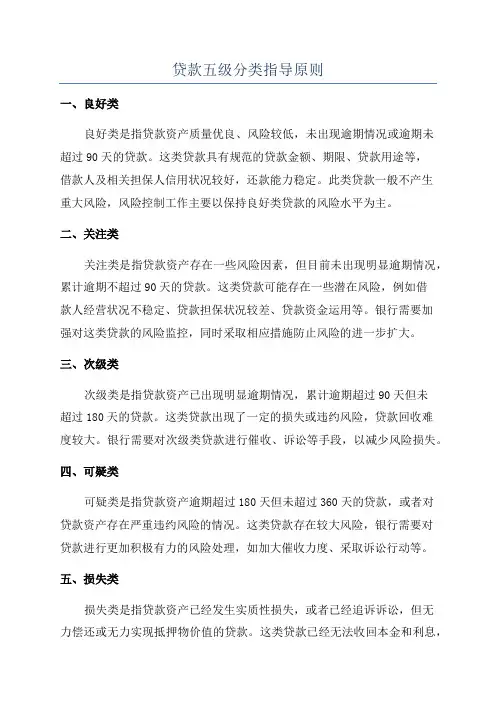
贷款五级分类指导原则一、良好类良好类是指贷款资产质量优良、风险较低,未出现逾期情况或逾期未超过90天的贷款。
这类贷款具有规范的贷款金额、期限、贷款用途等,借款人及相关担保人信用状况较好,还款能力稳定。
此类贷款一般不产生重大风险,风险控制工作主要以保持良好类贷款的风险水平为主。
二、关注类关注类是指贷款资产存在一些风险因素,但目前未出现明显逾期情况,累计逾期不超过90天的贷款。
这类贷款可能存在一些潜在风险,例如借款人经营状况不稳定、贷款担保状况较差、贷款资金运用等。
银行需要加强对这类贷款的风险监控,同时采取相应措施防止风险的进一步扩大。
三、次级类次级类是指贷款资产已出现明显逾期情况,累计逾期超过90天但未超过180天的贷款。
这类贷款出现了一定的损失或违约风险,贷款回收难度较大。
银行需要对次级类贷款进行催收、诉讼等手段,以减少风险损失。
四、可疑类可疑类是指贷款资产逾期超过180天但未超过360天的贷款,或者对贷款资产存在严重违约风险的情况。
这类贷款存在较大风险,银行需要对贷款进行更加积极有力的风险处理,如加大催收力度、采取诉讼行动等。
五、损失类损失类是指贷款资产已经发生实质性损失,或者已经追诉诉讼,但无力偿还或无力实现抵押物价值的贷款。
这类贷款已经无法收回本金和利息,存在较大的风险损失。
银行需要将这类贷款从资产负债表中清除,并采取相应的风险应对措施。
1.透明度原则:贷款五级分类应该以客观和透明的标准进行,能够被各级监管机构、借款人和公众所理解和接受。
2.谨慎性原则:对于出现风险的贷款,银行应该进行及时而准确的评估和分类,以便及时采取相应的风险处理措施。
3.全面性原则:银行应该根据贷款的实际情况,综合考虑各种风险因素,确保贷款分类的全面性和准确性。
4.独立性原则:贷款分类应该独立于交易利益相关方的影响,评估和处理应该建立在客观、公正和独立的基础上。
5.可操作性原则:贷款分类应该能够给监管机构、借款人和投资者提供有用的信息,以供其进行风险评估和决策。
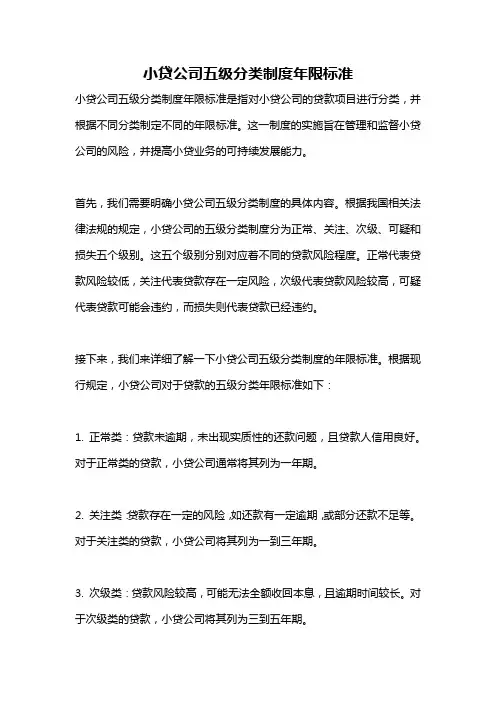
小贷公司五级分类制度年限标准小贷公司五级分类制度年限标准是指对小贷公司的贷款项目进行分类,并根据不同分类制定不同的年限标准。
这一制度的实施旨在管理和监督小贷公司的风险,并提高小贷业务的可持续发展能力。
首先,我们需要明确小贷公司五级分类制度的具体内容。
根据我国相关法律法规的规定,小贷公司的五级分类制度分为正常、关注、次级、可疑和损失五个级别。
这五个级别分别对应着不同的贷款风险程度。
正常代表贷款风险较低,关注代表贷款存在一定风险,次级代表贷款风险较高,可疑代表贷款可能会违约,而损失则代表贷款已经违约。
接下来,我们来详细了解一下小贷公司五级分类制度的年限标准。
根据现行规定,小贷公司对于贷款的五级分类年限标准如下:1. 正常类:贷款未逾期,未出现实质性的还款问题,且贷款人信用良好。
对于正常类的贷款,小贷公司通常将其列为一年期。
2. 关注类:贷款存在一定的风险,如还款有一定逾期,或部分还款不足等。
对于关注类的贷款,小贷公司将其列为一到三年期。
3. 次级类:贷款风险较高,可能无法全额收回本息,且逾期时间较长。
对于次级类的贷款,小贷公司将其列为三到五年期。
4. 可疑类:贷款存在严重违约的可能性,可能无法收回本息。
对于可疑类的贷款,小贷公司将其列为五到十年期。
5. 损失类:贷款已经无法收回本息,无可能追回的情况。
对于损失类的贷款,小贷公司不再设置年限。
以上年限标准的具体数值可能会因不同地区、不同监管要求而有所差异。
但总体来说,小贷公司五级分类制度的年限标准能够根据贷款的风险程度和违约可能性,合理划定贷款的期限。
此外,需要注意的是,小贷公司应该根据实际情况对贷款进行动态管理,并及时调整年限标准。
例如,当原本被归类为关注类的贷款在后续还款过程中出现了实质性的还款问题,可能会导致其从关注类变为次级类或可疑类。
在这种情况下,小贷公司应当相应地延长贷款期限,以便更好地应对风险。
总的来说,小贷公司五级分类制度年限标准的确定是为了管理和监督小贷公司的贷款风险,确保小贷业务的健康发展。

北京市小额贷款公司贷款五级分类在探讨北京市小额贷款公司贷款五级分类之前,我们首先需要了解什么是小额贷款公司以及为什么需要对其贷款进行五级分类。
小额贷款公司是指专门为小微企业、个体工商户以及困难群体提供小额贷款的金融机构。
这些机构在提供融资的也承担了很高的风险。
为了规范管理和防范风险,监管部门对其贷款进行了五级分类,并要求小额贷款公司根据五级分类提取风险准备金。
对于小额贷款公司而言,五级分类是非常重要的,它直接关系到其资产质量和经营风险。
我们来看一下北京市小额贷款公司贷款五级分类的具体含义。
北京市小额贷款公司贷款五级分类是指根据贷款资产的不同风险程度,将其分为五个等级,分别为正常、关注、次级、可疑和损失。
正常指的是按时足额偿还本息的贷款;关注指的是可能出现一定风险的贷款;次级指的是存在较大违约风险但尚未到不可收回的地步;可疑指的是已经发生了不良信号,存在较大违约风险,可能需要通过追索、诉讼等手段来收回本金和利息;损失指的是贷款回收的可能性非常小,已经确认为损失。
区分这五个等级的依据主要包括贷款的拖欠程度、担保情况、还款来源等多个方面的指标。
这种分类方式不仅可以帮助小额贷款公司全面了解其资产质量,还可以帮助监管部门对小额贷款公司的风险进行监控和预警。
通过分类管理,监管部门可以更加及时地发现和化解风险,保障金融体系的稳定运行。
接下来,我想共享一下我对北京市小额贷款公司贷款五级分类的一些个人观点和理解。
我认为这种分类方式在一定程度上能够促进小额贷款公司提高风险意识和风险管理能力。
通过分类管理,小额贷款公司不仅能够更准确地评估贷款风险,还能够有效地制定风险防范和化解措施,提升整体风险管理水平。
对于借款人而言,五级分类也能够促使其更加自觉地履行还款义务,因为贷款的五级分类直接关系到借款人的信用记录和未来的融资成本。
北京市小额贷款公司贷款五级分类是监管部门对小额贷款公司风险管理的重要制度安排,具有重要的实践意义和现实价值。
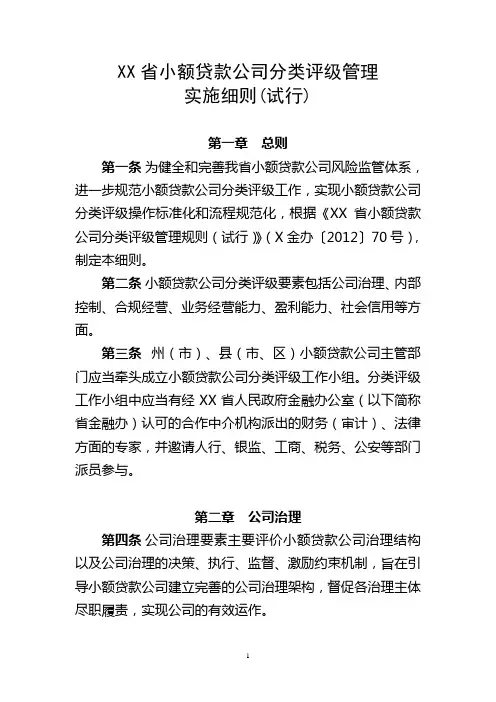
XX省小额贷款公司分类评级管理实施细则(试行)第一章总则第一条为健全和完善我省小额贷款公司风险监管体系,进一步规范小额贷款公司分类评级工作,实现小额贷款公司分类评级操作标准化和流程规范化,根据《XX省小额贷款公司分类评级管理规则(试行)》(X金办…2012‟70号),制定本细则。
第二条小额贷款公司分类评级要素包括公司治理、内部控制、合规经营、业务经营能力、盈利能力、社会信用等方面。
第三条州(市)、县(市、区)小额贷款公司主管部门应当牵头成立小额贷款公司分类评级工作小组。
分类评级工作小组中应当有经XX省人民政府金融办公室(以下简称省金融办)认可的合作中介机构派出的财务(审计)、法律方面的专家,并邀请人行、银监、工商、税务、公安等部门派员参与。
第二章公司治理第四条公司治理要素主要评价小额贷款公司治理结构以及公司治理的决策、执行、监督、激励约束机制,旨在引导小额贷款公司建立完善的公司治理架构,督促各治理主体尽职履责,实现公司的有效运作。
本要素分值共10分。
第五条公司股东会(股东大会)、董事会(执行董事)、监事会(监事)、高级管理层各主体之间权责明确,有效运作,并发挥了积极作用的,得2分;各个主体有权责划分,能够运作,得1分;各个主体权责不分或者存在严重交叉,得0分。
评级时,应结合公司章程、三会议事规则、三会会议决议、三会会议记录、三会会议材料等进行综合判断,包括有关议事规则的制定是否履行了必要的程序,是否按照议事规则和决策程序召开会议、履行职责,相关档案资料是否完整保存,有关会议决议、会议记录是否有参会人员签字等。
第六条董事、监事和高级管理人员的任职资格符合要求的,得2分;董事、监事和高级管理人员中存在未经省金融办的任职资格审核或者实际履职人员与通过资格审核的人员不一致等情形的,得0分。
评级时,应当重点审查公司章程是否明确规定了董事、监事、高级管理人员等的人数、产生办法、任免程序及任职资格是否经过审核等内容。
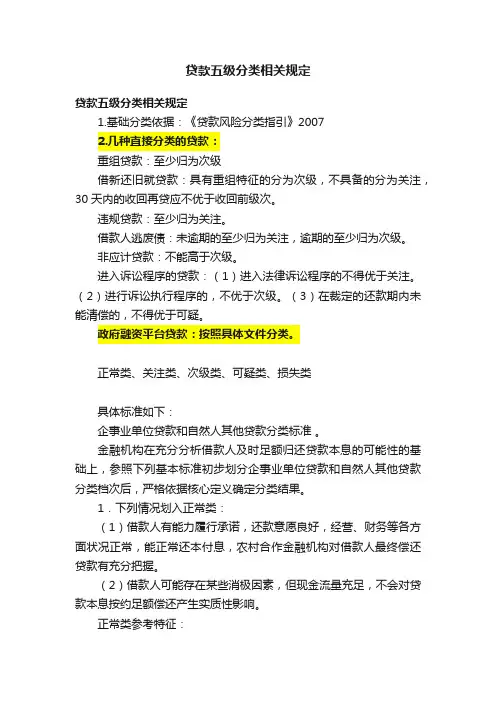
贷款五级分类相关规定贷款五级分类相关规定1.基础分类依据:《贷款风险分类指引》20072.几种直接分类的贷款:重组贷款:至少归为次级借新还旧就贷款:具有重组特征的分为次级,不具备的分为关注,30天内的收回再贷应不优于收回前级次。
违规贷款:至少归为关注。
借款人逃废债:未逾期的至少归为关注,逾期的至少归为次级。
非应计贷款:不能高于次级。
进入诉讼程序的贷款:(1)进入法律诉讼程序的不得优于关注。
(2)进行诉讼执行程序的,不优于次级。
(3)在裁定的还款期内未能清偿的,不得优于可疑。
政府融资平台贷款:按照具体文件分类。
正常类、关注类、次级类、可疑类、损失类具体标准如下:企事业单位贷款和自然人其他贷款分类标准。
金融机构在充分分析借款人及时足额归还贷款本息的可能性的基础上,参照下列基本标准初步划分企事业单位贷款和自然人其他贷款分类档次后,严格依据核心定义确定分类结果。
1.下列情况划入正常类:(1)借款人有能力履行承诺,还款意愿良好,经营、财务等各方面状况正常,能正常还本付息,农村合作金融机构对借款人最终偿还贷款有充分把握。
(2)借款人可能存在某些消极因素,但现金流量充足,不会对贷款本息按约足额偿还产生实质性影响。
正常类参考特征:a.借款人生产经营正常,主要经营指标合理,现金流量充足,一直能够正常足额偿还贷款本息。
b.贷款未到期。
c.本笔贷款能按期支付利息2.有下列情况之一的一般划入关注类:(1)借款人的销售收入、经营利润下降或出现流动性不足的征兆,一些关键财务指标出现异常性的不利变化或低于同行业平均水平;(2)借款人或有负债(如对外担保、签发商业汇票等)过大或与上期相比有较大幅度上升;(3)借款人的固定资产贷款项目出现重大的不利于贷款偿还的因素(如基建项目工期延长、预算调增过大);(4)借款人经营管理存在重大问题或未按约定用途使用贷款;(5)借款人或担保人改制(如分立、兼并、租赁、承包、合资、股份制改造等)对贷款可能产生不利影响;(6)借款人的主要股东、关联企业或母子公司等发生了重大的不利于贷款偿还的变化;(7)借款人的管理层出现重大意见分歧或者法定代表人和主要经营者的品行出现了不利于贷款偿还的变化;(8)违反行业信贷管理规定或监管部门监管规章发放的贷款;(9)借款人在其他金融机构贷款被划为次级类;(10)宏观经济、市场、行业、管理政策等外部因素的变化对借款人的经营产生不利影响,并可能影响借款人的偿债能力;(11)借款人处于停产或半停产,但抵(质)押率充足,抵质押物远远大于实现贷款本息得价值和实现债权得费用,对最终收回贷款有充足的把握。

第一章总则第一条为提高公司信贷管理水平,增强风险预警能力,防范和化解信贷风险,根据有关小额贷款公司的政策规定,制定本实施细则。
第二条本实施细则适用于公司所有贷款风险分类。
第三条贷款风险分类(以下简称风险分类),是指按照风险程度将公司贷款划分为不同档次的过程。
通过风险分类应达到以下目的:(一)促进公司树立审慎经营、风险为本的管理理念;(二)揭示贷款的实际价值和风险程度,真实、全面、动态地反映贷款质量;(三)及时发现贷款发放、管理、监控、催收以及不良贷款管理中存在的问题,提高经营管理水平;(四)为充分提取贷款损失准备金提供依据,增强抗风险能力。
第四条风险分类要坚持风险、真实、审慎、灵活及动态管理的原则。
(一)风险原则。
五级分类应以贷款的内在风险为主要依据,逾期情况只作为一个重要参考因素。
内在风险是指潜在的、已经发生但尚未实现的风险。
(二)真实原则。
应当以借款人的财务状况、经营成果、现金流量、信用记录为主要依据,对各类贷款质量准确分类,真实反映出贷款的风险状况。
(三)审慎原则。
要按照《贷款风险分类指导原则》和本实施细则要求,通过对影响债务人偿还债务可能性的诸多因素的定性与定量分析、评估,合理划分风险类别。
介于相邻类别之间的贷款原则上归入低级档次。
(四)灵活原则。
贷款原则上应逐笔分类。
同一借款人在小额贷款公司监管政策规定的最高贷款限额范围内有多笔贷款的,在不影响总的分类结果的前提下,可将多笔贷款合并分类。
(五)动态管理原则。
公司贷款多为短期(不超过1年),原则上1—2个月必须进行一次贷后检查,在此基础上进行贷款分类,及时、动态地掌握影响贷款回收相关因素的变化情况,对风险状况已发生重大变化的应及时重新认定。
第五条对贷款进行风险分类应按户分析,根据借款人的整体还款可能性揭示贷款风险,并以评估借款人的还款能力为核心,把借款人的正常业务经营收入作为贷款的主要还款来源,贷款的担保作为次要还款来源。
第二章核心定义第六条评估公司贷款质量,采用以风险为基础的分类方法,按照按时、足额收回的可能性将贷款分为正常、关注、次级、可疑和损失五个类别,其中,后三类合称为不良贷款。
![[实用参考]贷款质量五级分类操作细则.doc](https://uimg.taocdn.com/5bbadf38168884868762d6e0.webp)
西宁市商业银行贷款质量五级分类操作细则目录第一章总则第二章贷款质量五级分类的部门及职责权限第三章五级分类的标准和主要特征第四章贷款五级分类的原则及特别规定第五章贷款五级分类工作流程第六章贷款五级分类的操作方法第七章贷款损失准备金的提取第八章贷款五级分类考核与评价第九章贷款五级分类后期管理第十章罚责第十一章附则第一章总则第一条为进一步完善我行风险分类管理制度,真实、全面、动态反映贷款风险程度,加强信贷管理,提高信贷资产质量,防范化解信贷风险。
根据中国人民银行《贷款风险分类指导原则》、《中国人民银行关于城市商业银行贷款质量五级分类实施意见》及《中国银行业监督管理委员会关于推行和完善贷款风险分类工作的通知》并结合我行实际情况,制定本实施细则。
第二条贷款质量五级分类所称“贷款”包括:一般贷款(含抵押、质押、保证、信用等贷款)、贴现、银行承兑汇票垫款、信用证垫款、担保垫款、进出口押汇、银行卡透支、拆出资金、存放同业、应收账款等类似性质的其他债权及类似性质的或有负债。
第三条贷款质量五级分类是评价贷款风险状况的一种方法。
严格按照贷款质量五级分类的标准、方法和程序对贷款风险进行评估和揭示,并及时提取贷款损失准备金,是防范经营风险的重要手段。
第四条贷款质量五级分类是指按贷款本金利息收回的可能性,将贷款划分为正常、关注、次级、可疑和损失五个类别,其中次级、可疑和损失类合并称为不良贷款。
第五条贷款质量五级分类必须严格按照分类的标准、程序、方法进行初分和认定,按审批权限进行审批。
并纳入日常信贷管理工作。
第六条通过贷款风险分类应达到以下目标:(一)可以使信贷业务经办人员及时发现其管理的信贷资产的实际价值和风险程度,动态、真实、全面地把握信贷资产的质量状况;(二)可以使贷款管理人员及时发现贷款评估、审批、发放、管理、监控、催收以及不良贷款管理中存在的问题,加强基础管理;(三)为分析和预警信贷风险、制定信贷政策及收贷收息和开拓业务提供依据;(四)正确评价各级支行信贷经营管理工作绩效,为信贷业务授权提供依据;(五)为判断贷款损失准备金是否充足提供依据。
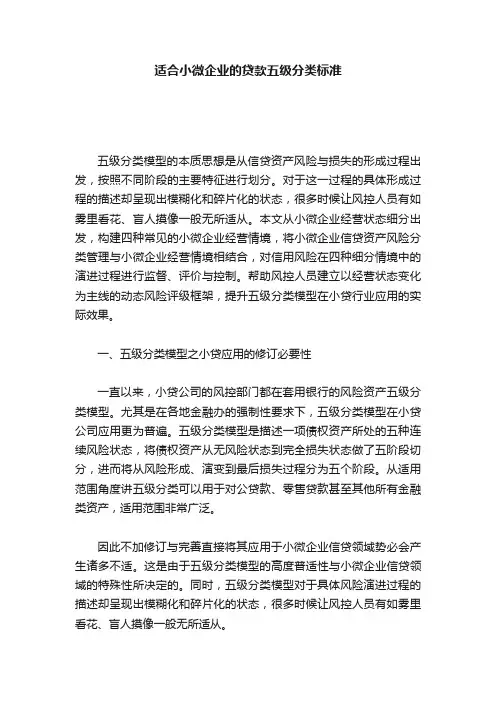
适合小微企业的贷款五级分类标准五级分类模型的本质思想是从信贷资产风险与损失的形成过程出发,按照不同阶段的主要特征进行划分。
对于这一过程的具体形成过程的描述却呈现出模糊化和碎片化的状态,很多时候让风控人员有如雾里看花、盲人摸像一般无所适从。
本文从小微企业经营状态细分出发,构建四种常见的小微企业经营情境,将小微企业信贷资产风险分类管理与小微企业经营情境相结合,对信用风险在四种细分情境中的演进过程进行监督、评价与控制。
帮助风控人员建立以经营状态变化为主线的动态风险评级框架,提升五级分类模型在小贷行业应用的实际效果。
一、五级分类模型之小贷应用的修订必要性一直以来,小贷公司的风控部门都在套用银行的风险资产五级分类模型。
尤其是在各地金融办的强制性要求下,五级分类模型在小贷公司应用更为普遍。
五级分类模型是描述一项债权资产所处的五种连续风险状态,将债权资产从无风险状态到完全损失状态做了五阶段切分,进而将从风险形成、演变到最后损失过程分为五个阶段。
从适用范围角度讲五级分类可以用于对公贷款、零售贷款甚至其他所有金融类资产,适用范围非常广泛。
因此不加修订与完善直接将其应用于小微企业信贷领域势必会产生诸多不适。
这是由于五级分类模型的高度普适性与小微企业信贷领域的特殊性所决定的。
同时,五级分类模型对于具体风险演进过程的描述却呈现出模糊化和碎片化的状态,很多时候让风控人员有如雾里看花、盲人摸像一般无所适从。
五级分类模型的本质思想是从信贷资产风险与损失的形成过程出发按照不同阶段偿还能力的主要特征进行划分(参见表一)。
因此关于偿还能力的综合评价成为分类科学性的关键环节,进而使问题回归到了信贷业务的关键成功因素---偿还能力评估本身。
所以,从本质上讲如果小贷公司对偿还能力的评估没有一套系统的框架与方法,是无法构建一套科学的五级分类体系的,更无法将贷后管理与五级分类体系有机结合形成动态风险监控系统。
再进一步讲,比较清楚的逻辑是,五级分类模型的应用是期望它帮助我们建立一套动态监控客户偿还能力的监控系统,如果静态的监控系统还存在问题,那么五级分类并不能帮我们解决监控风险的本质问题。
小额贷款公司贷款五级分类管理办法第一章总则第一条为加强信贷风险管理,提高风险信贷质量,根据中国银监会《贷款风险分类指引》,特制定本办法。
第二条本办法所称信贷资产质量五级分类(以下简称“五级分类”),是指采用以风险为基础的分类方法,把信贷资产分为正常、关注、次级、可疑和损失五类。
后三类合称为不良信贷资产。
其核心定义分别为:1、正常:债务人能够履行合同,有充分理由表明能够按期足额偿还债务。
2、关注:尽管债务人目前有能力偿还债务,但存在一些可能对偿还产生不利影响的因素。
3、次级:债务人的偿债能力出现明显问题,完全依靠其正常营业收入无法足额偿还债务,即使执行担保,也可能会造成一定损失。
4、可疑:债务人无法足额偿还债务,即使执行担保,也肯定要造成较大损失。
5、损失:在采取所有可能的措施或一切必要的法律程序后,债务依然无法收回,或只能收回极少部分。
第三条通过信贷资产质量五级分类,应达到以下目标:(一)揭示信贷资产的实际价值和风险程度,真实、全面、动态的反映信贷资产质量。
(二)为提取减值准备提供依据。
第二章企业贷款分类标准第四条正常类贷款(一)借款人有能力履行承诺,还款意愿良好,经营、财务等各方面状况正常,能正常还本付息,对借款人最终偿还贷款有充分把握;(二)借款人可能存在某些消极因素,但现金流量充足,不会对贷款本息按约足额偿还产生实质性影响;贷款损失的概率为0。
正常类贷款参考特征:(1)借款人生产经营正常,主要经营指标合理,现金流量充足,一直能够足额偿还贷款本息;(2)贷款未到期;(3)本笔贷款能按期支付利息。
第五条关注类贷款(一)借款人的销售收入、经营利润下降或出现流动性不足的征兆,一些关键财务指标出现异常性的不利变化或低于同行业平均水平;(二)借款人或有负债(如对外担保、签发商业汇票等)过大或与上期相比有较大幅度上升;(三)借款人的固定资产贷款项目出现重大的不利于贷款偿还的因素(如基建项目工期延长、预算调增过大);(四)借款人经营管理存在重大问题或未按约定用途使用贷款;(五)借款人或担保人改制(如分立、兼并、租赁、承包、合资、股份制改造等)对贷款可能产生不利影响;(六)借款人的主要股东、关联企业或母子公司等发生了重大的不利于贷款偿还的变化;(七)借款人的管理层出现重大意见分歧或者法定代表人和主要经营者的品行出现了不利于贷款偿还的变化;(八)借款人在其他金融机构贷款被划为次级类;(九)宏观经济、市场、行业、管理政策等外部因素的变化对借款人的经营产生不利影响,并可能影响借款人的偿债能力;(十)借款人处于停产或半停产,但抵(质)押率充足,抵质押物远远大于实现贷款本息得价值和实现债权得费用,对最终收回贷款有充足的把握;(十一)借新还旧贷款,企业运转正常且能按约还付息的;(十二)借款人偿还贷款能力较差,但担保人代为偿还能力较强;(十三)贷款的抵押物、质押物价值下降,或农村合作金融机构对抵(质)押物失去控制;保证的有效性出现问题,可能影响贷款归还;(十四) 本金或利息逾期(含展期,下同)90天(含)以内的贷款;(十五)贷款损失的概率不会超过5%。
小额贷款公司贷款五级分类实施细则(样本)第一章总则第一条为提高公司信贷管理水平,增强风险预警能力,防范和化解信贷风险,根据《贷款风险分类指导原则》(银发[2001]416号)和有关小额贷款公司的政策规定,制定本实施细则。
第二条本实施细则适用于公司所有贷款风险分类。
第三条贷款风险分类(以下简称风险分类),是指按照风险程度将公司贷款划分为不同档次的过程。
通过风险分类应达到以下目的:(一)促进公司树立审慎经营、风险为本的管理理念;(二)揭示贷款的实际价值和风险程度,真实、全面、动态地反映贷款质量;(三)及时发现贷款发放、管理、监控、催收以及不良贷款管理中存在的问题,提高经营管理水平;(四)为充分提取贷款损失准备金提供依据,增强抗风险能力。
第四条风险分类要坚持风险、真实、审慎、灵活及动态管理的原则。
(一)风险原则。
五级分类应以贷款的内在风险为主要依据,逾期情况只作为一个重要参考因素。
内在风险是指潜在的、已经发生但尚未实现的风险。
(二)真实原则。
应当以借款人的财务状况、经营成果、现金流量、信用记录为主要依据,对各类贷款质量准确分类,真实反映出贷款的风险状况。
(三)审慎原则。
要按照《贷款风险分类指导原则》和本实施细则要求,通过对影响债务人偿还债务可能性的诸多因素的定性与定量分析、评估,合理划分风险类别。
介于相邻类别之间的贷款原则上归入低级档次。
(四)灵活原则。
贷款原则上应逐笔分类。
同一借款人在小额贷款公司监管政策规定的最高贷款限额范围内有多笔贷款的,在不影响总的分类结果的前提下,可将多笔贷款合并分类。
(五)动态管理原则。
公司贷款多为短期(不超过1年),原则上1—2个月必须进行一次贷后检查,在此基础上进行贷款分类,及时、动态地掌握影响贷款回收相关因素的变化情况,对风险状况已发生重大变化的应及时重新认定。
第五条对贷款进行风险分类应按户分析,根据借款人的整体还款可能性揭示贷款风险,并以评估借款人的还款能力为核心,把借款人的正常业务经营收入作为贷款的主要还款来源,贷款的担保作为次要还款来源。
贷款五级分类指引篇一:小额贷款公司贷款五级分类办法小额贷款有限公司贷款五级分类管理办法第一章总则第一条为加强信贷风险管理,提高风险信贷质量,根据中国银监会《贷款风险分类指引》,福清市融凯小额贷款有限公司《信贷业务管理制度》及有关规定,特制定本办法。
第二条本办法所称信贷资产质量五级分类(以下简称“五级分类”),是指采用以风险为基础的分类方法,把信贷资产分为正常、关注、次级、可疑和损失五类。
后三类合称为不良信贷资产。
其核心定义分别为:1、正常:债务人能够履行合同,有充分理由表明能够按期足额偿还债务。
2、关注:尽管债务人目前有能力偿还债务,但存在一些可能对偿还产生不利影响的因素。
3、次级:债务人的偿债能力出现明显问题,完全依靠七正常营业收入无法足额偿还债务,即使执行担保,也可能会造成一定损失。
4、可疑:债务人无法足额偿还债务,即使执行担保,也肯定要造成较大损失。
5、损失:在采取所有可能的措施或一切必要的法律程序后,债务依然无法收回,或只能收回极少部分。
第三条通过信贷资产质量五级分类,应达到以下目标:(一)揭示信贷资产的实际价值和风险程度,真实、全面、动态的反映信贷资产质量。
(二)为提取减值准备提供依据。
第二章企业贷款分类标准第四条正常类贷款特征包括:(一)借款人生产经营正常,主要经营指标合理,现金流量充足,一直能够足额偿还贷款本息;(二)贷款未到期;(三)本笔贷款能按期支付利息;(四)如有国债、金融债券、银行存单、100%保证金作为质押,贷款逾期未超过三个月(含)。
符合规定的低风险信贷业务,可直接认定为正常类贷款。
第五条关注类贷款特征包括:(一)宏观经济、行业、市场、技术、产品、企业内部经营管理或财务状况发生变化,对借款人正常经营产生不利影响,但其偿还贷款的能力尚未出现明显问题。
(二)借款人改制(如合并、分立、承包、租赁等),对本公司债权可能产生不利影响;(三)借款人的主要股东、关联企业或母子公司等发生不利变化;借款人管理层发生重大变化,且新任管理层还款意愿较差。
贷款五级分类标准根据中国人民银行制定的《贷款分类指导原则》,******小额贷款有限公司(以下简称公司)依据借款人的实际还款能力进行贷款质量的五级分类,即按风险程度将贷款划分为五类:正常、关注、次级、可疑、损失,后三种为不良贷款。
一、正常贷款借款人能够履行合同,一直能正常还本付息,不存在任何影响贷款本息及时全额偿还的消极因素,公司对借款人按时足额偿还贷款本息有充分把握。
贷款损失的概率为0。
详细标准:(一)借款人有能力履行承诺,还款意愿良好,经营、财务等各方面状况正常,能正常还本付息,本公司对借款人最终偿还贷款有充分把握;(二)借款人可能存在某些消极因素,但现金流量充足,不会对贷款本息按约足额偿还产生实质性影响。
正常类参考特征:1、借款人生产经营正常,主要经营指标合理,现金流量充足,一直能够正常足额偿还贷款本息。
2、贷款未到期。
3、本笔贷款能按期支付利息。
二、关注贷款尽管借款人目前有能力偿还贷款本息,但存在一些可能对偿还产生不利影响的因素,如这些因素继续下去,借款人的偿还能力受到影响,贷款损失的概率不会超过5%。
详细标准:(一)借款人的销售收入、经营利润下降或出现流动性不足的征兆,一些关键财务指标出现异常性的不利变化或低于同行业平均水平;(二)借款人或有负债(如对外担保等)过大或与上期相比有较大幅度上升;(三)借款人的固定资产贷款项目出现重大的不利于贷款偿还的因素(如基建项目工期延长、预算调增过大);(四)借款人经营管理存在重大问题或未按约定用途使用贷款;(五)借款人或担保人改制(如分立、兼并、租赁、承包、合资、股份制改造等)对贷款可能产生不利影响;(六)借款人的主要股东、关联企业或母子公司等发生了重大的不利于贷款偿还的变化;(七)借款人的管理层出现重大意见分歧或者法定代表人和主要经营者的品行出现了不利于贷款偿还的变化;(八)违反行业信贷管理规定或监管部门监管规章发放的贷款;(九)借款人在其他金融机构贷款被划为次级类;(十)宏观经济、市场、行业、管理政策等外部因素的变化对借款人的经营产生不利影响,并可能影响借款人的偿债能力;(十一)借款人处于停产或半停产,但抵(质)押率充足,抵质押物远远大于实现贷款本息的价值和实现债权的费用,对最终收回贷款有充足的把握;(十二)借新还旧贷款,企业运转正常且能按约还本付息的;(十三)借款人偿还贷款能力较差,但担保人代为偿还能力较强;(十四)贷款的抵押物、质押物价值下降,或本公司对抵(质)押物失去控制;保证的有效性出现问题,可能影响贷款归还;(十五)本金或利息逾期(含展期,下同)90天(含)以内的贷款。
6.小额贷款公司贷款五级分类实施...6.小额贷款公司贷款五级分类实施细则(The detailed rules for the implementation of the five level classification of 6. small loan company loans)Detailed rules for the implementation of the five level classification of loans for small loan companiesChapter 1 General ProvisionsFirst, in order to improve the level of corporate credit management, enhance the ability of risk early warning, prevent and resolve credit risk, according to the loanThe guiding principle of risk classification ([2001]416) and the policy provisions of small loan companies, the formulation of the implementation of the fineThen.The second detailed rules are applicable to the classification of all the loan risks of the company.The third loan risk classification (hereinafter referred to as risk classification) refers to the degree of risk, the company loan is divided into differentGrade process. The following objectives should be achieved through risk classification:(1) to promote the establishment of prudent management and risk oriented management concept;(two) reveal the actual value and risk level of loans, and reflect the quality of loans truly, comprehensively and dynamically;(three) find out the problems existing in the management of loans, management, monitoring, collection and bad loans in time, and improve the quality of the loansBattalion management level;(four) provide the basis for fully extracting the loan loss reserve, and enhance the ability to resist risks.The fourth risk classification should adhere to the principles of risk, truthfulness, prudence, flexibility and dynamic management.(1) risk principle. The five level classification should be based on the inherent risk of loan, and overdue situation is only one importantReference factors. Inherent risk refers to potential, already occurred but not yet realized risk.(two) the principle of truth. The borrower's financial condition, operating results, cash flow and credit record should be the main basisAccording to the accurate classification of various types of loan, the risk situation of the loan is truly reflected.(three) prudence principle. In accordance with the "loan risk classification guidelines" and the implementation of the requirements of the rules, through the impact of debt Qualitative and quantitative analysis and evaluation of the factors of the possibility of repayment of debt, and reasonable division of risk categories. Between adjacent classesThe loans between them fall into low grades in principle.(four) flexible principle. The principle of the loan should be classified by. The same borrower in the regulatory policy of small loan companiesThere are many loans within the scope of the maximum loan limit, without affecting the overall classification results, we can merge multiple loansClass.(five) dynamic management principle. Corporate loans are mostly short term (not more than 1 years). In principle, 1 - 2 months must be carried outAfter the subprime mortgage inspection, on this basis, the loan classification, timely and dynamically grasp the impact of loan recovery related factors changeIf the risk situation has undergone major changes, it should be re identified in time.The fifth risk classification of loans should be analyzed by the household, and the loan risk can be revealed according to the possibility of the borrower's overall repayment,To assess the borrower's repayment ability as the core, the borrower's normal business income as the main source of repayment of loans,Loan guarantees are a secondary source of repayment.The second chapter is the core definitionThe sixth one is to evaluate the quality of the loan, and adopt the risk based classification method, which can be recovered in time and in fullThe loan can be divided into five categories: normal, concern, secondary, suspicious and loss, among which the latter three categories are called non-performing loans.(a) normal: the borrower can perform the contract, there is no sufficient reason to doubt the loan principal and interest can not be repaid in full and on time.(two) concern: Although the borrower has the ability to repay the loan principal and interest, but there are some possible adverse effects on repaymentSound factor.(three) secondary: the borrower's repayment ability hasobvious problems, and can not be fully repaid by its normal operating incomeLoan principal and interest, even if the implementation of the guarantee, may also cause certain losses.(four) suspicious: the borrower can not repay the principal and interest of the loan in full, even if the implementation of the guarantee, it is bound to cause greater losses.(five) loss: the principal and interest can not be recovered after all possible measures or all necessary legal procedures, Or only a small part of it can be recovered.The third chapter, risk classification methodSeventh, according to the business characteristics of the company and different borrowers, the loan is divided into enterprise loans (mainly refers to small and medium-sized enterprises, "three")(Agriculture) and natural person loans (including individual industrial and commercial households). Different classifications of loans used by different borrowers.(1) enterprise loans use financial analysis, cash flow analysis, non financial analysis, guarantee analysis tools, comprehensive evaluationClassify the borrowers on the basis of their final repayment ability.(two) natural person loans can simplify procedures, according to their credit rating, repayment of debt, work, personal and homeThe income of the court, the guarantee conditions and other factors are classified.The fourth chapter is the basis of risk classificationEighth company risk classification personnel (credit andreview personnel) through a variety of on-site, off-site access and Analysis methods, to obtain the borrower's financial, cash flow, non-financial and guarantee the real information in all aspects, using financial analysis,Cash flow analysis, non-financial analysis, security analysis tools to assess the impact of borrower repayment ability of various factorsThe evaluation conclusion is the main basis for determining the classification of loans.The evaluation of the ninth financial conditions refers to the investigation of the borrower's operating conditions and financial strength,To confirm and compare the data in the borrower's financial statements, focus on the borrower's short-term debt paying ability,Profitability and operating capacity, and comprehensively assess the borrower's financial position.The tenth cash flow analysis refers to the evaluation and borrowing according to the information of cash and cash equivalents in the borrower's cash flow statementThe ability, time and certainty of the borrower's generation, use of cash and cash equivalents to determine the borrower's business activities and financing activitiesThe influence of net cash flow on repayment ability. The method and the gist of cash flow analysis are also applicable to individual creditor's rightsAn analysis of the cash and cash equivalents of individuals and households in income, expenditure and borrowing.Eleventh guarantees analysis refers to the borrower or the third party provides the creditor's rights safeguard measurecarries on the analysis, divides into the guarantee,Mortgage and pledge in three ways. Mainly from the validity of the law, the value of the adequacy of security during the period of security and continuityThe variable performance is evaluated to determine the effectof the guarantee as the second source of repayment on the borrower's repayment ability. MortgageThe market value is determined according to the market price; there is no market reference to the market value of similar collateral.The twelfth non-financial factors include the industry risk factors of the borrower (including the cost structure, the growth stage of the industry),Economic periodicity, profitability and dependence of industry, substitutability of products, laws and policies, economic and technological environment, etc.,Operating risk factors (including borrower size, development stage, product diversification, business strategy, product and market)Analysis, production and sales link analysis, and management risk factors (including borrower organization form, management quality and experience),The stability of management, the quality of employees, etc., natural and social factors, repayment records (including the repayment records in the bank), repaymentWillingness, guarantee of loans, legal liabilities for repayment of debts, etc..The fifth chapter, risk classification standardThe thirteenth article is based on the analysis of thepossibility of the borrower in time and full repayment of the loan principal and interest, referring to the following basic After the classification of loan classification standards, the classification results are strictly determined according to the core definition.1. The following cases are classified as normal:1. borrowers have the ability to fulfill the contract, repayment willingness is good, business, finance and other aspects of the normal situation, can repay the principal on timeInterest payments, to the borrower to fully repay the loan is fully assured.2. borrowers in some areas even if there are some negative factors, but does not affect the loan principal and interest repaid in full on time.Two, one of the following categories is generally classified into concern category:OneThe borrower's sales income, operating profit decline or liquidity shortage symptoms, some key financial indicators (principal)Including liquidity ratio, asset liability ratio, sales profit margin, asset profitability, accounts receivable turnover, inventory turnover,And the owner's equity, cash flow, the abnormal adverse changes or lower than the average level of the industry;2. borrowers or liabilities (such as external guarantees, the issuance of commercial bills, etc.) too large or compared with the previous period has a large extentL;3. the borrower's fixed assets loan project has majorunfavorable factors for loan repayment (such as the extension of infrastructure project duration),Excessive budget increase;4. there are serious problems in the management of the borrowers or loans are not used as agreed purposes;5. the reform of the borrowers (such as division, merger, lease, contract, joint venture, shareholding system reform, etc.) may not produce loansBenefit influence;6. the major shareholders of the borrower, affiliated enterprises or parent subsidiary companies have undergone major changes that are unfavorable to the repayment of loans;7. the behavior of the legal representative and the principal operator of the borrower appeared to be unfavorable to the repayment of the loan;8. borrowers are classified as subprime in other financial institutions;9. changes in external factors such as macro economy, market, industry and management policy have adverse effects on the operation of the borrowers,And may affect the borrower's solvency;10., the value of the collateral and pledge of the loan declined, or the company lost control over the pledged property, and the validity of the guaranteeProblems may affect loan repayment;Three, one of the following circumstances is generally classified as secondary class:1. the operating loss of the borrower is difficult to pay and the source of supplementary funds is difficult to meet, and the cash flow of the operation is negativeThe number of;2. borrowers can not repay debts to other creditors;3. borrowers have to maintain production operations by selling and selling major production and operating fixed assets, orTo raise repayment funds through auction of collateral, performance of guarantee liability, etc.;4. borrowers obtain loans through improper means such as concealing facts;5. there are problems in the internal management of the borrower, which constitutes substantial damage to the normal operation and hinders the timely and full payment of the debts;6. the credit files are not complete, the important legal documents are lost, and the repayment constitutes a substantial impact;7. borrowers are classified as suspicious in other financial institutions;Four. One of the following circumstances is generally classified as suspect:1. the borrower in production, semi shutdown state, the fixed asset loan project is stopped or postponed state;2. borrowers are actually insolvent;3. the borrower enters liquidation procedure;4. borrowers or their legal representatives involve major cases,which have a significant impact on the borrower's normal business activities;5., it is difficult for the borrower to implement the company loan debt or implement the debt, but can not repay the debt normally;6., after many negotiations, borrowers obviously no repayment intention;7. has resorted to law to pursue loans;8. borrowers are classified as loss classes in other financial institutions;Five, one of the following circumstances is generally included in the loss category:1. the company belongs to the type of loan business and in accordance with the "measures for the administration of financial enterprises" write offs (financial [2008]28) articleThe two chapter is the provisions of the conditions of the loans identified as bad debts;2. borrowers can not repay the loan, even if the disposition of the pledge or the recourse to the guarantor can only recover a small part of the loan,The loan loss rate is expected to exceed 90%.Classification standard of loans for fourteenth natural persons (including individual industrial and commercial households).1. normal class: borrower's family stability, physical condition and income status is good, in the loan period can be normal repaymentInterest.2. attention categories: the borrower has 2 consecutive default period; the loan principal or interest is overdue within 15 days (including), or borrowThe situation that the people suffered from major natural disasters and laid off unemployment obviously affect the repayment of loans.Collateral disposal, re financing and guarantor compensation,etc.. The stability and liquidity of various sources of repayment are different, and the degree of risk is differentAlso, its normal operating income is the most secure source of debt repayment. Analysis of the source of repayment, the focus is to identify the actual repaymentThe source and composition of the loan, whether the source of repayment is consistent with the original agreed, whether there is risk?.(3) asset conversion cycle analysis. The asset conversion cycleis the transformation of credit funds from financial capital into physical capitalThe process of converting physical capital into financial capital. Analysis focuses on product sales and inventory of enterprises, changes in accounts receivableThe outstanding changes of the borrower's asset structure, the progress of the loan project and so on. Through analysis, the arrangement of the loan period is examined,Whether the source of the repayment is matched with the asset conversion cycle?.(4) analysis of repayment records. By looking at the repayment records, to understand whether the loan is normal, debt service interest, whether serious arrears,Whether the loan through restructuring, principal overdue time, whether it has been stopped and credit interest receivable accumulation amount ofInterest, and according to the borrower's willingness to repay an important basis.(three) comprehensive assessment of loan repayment using financial analysis, cash flow analysis, non-financial analysis, and assurance analysis toolsPossibility. The main points of finance, cash flow,non-financial factors and guarantee analysis are summarized respectivelyThe main favorable factors and unfavorable factors that affect the repayment of loans, and complete the preliminary writing of classification work.(four) organize credit discussion and put forward initial opinions. The classification personnel should comprehensively evaluate the possibility of loan repaymentTo classify the loan data and to discuss the credit, focusing on the integrity of the loan data and the accuracy of the initial resultsThe opinions of the company are put forward and the audit opinions are signed by the general manager of the company.The company should record in detail the opinions of the participants in the credit discussion. Loans that are disputed with the classification results should also be noted in detail Issues and reasons in dispute, and filing management for future inspection, assessment or re identification.(five) review and confirm the result of classification. The company should submit the relevant information of loan classification to the company risk management committee Review and confirm the classification results according to the authority. Loans that are disputed on the classification results shall be recorded for future reference.Twenty-first natural person loan classification procedures: collect and fill the basic information of loan classification brief analysis,To evaluate the possibility of loan repayment: to discuss the organizational credit, to put forward the initial opinion, toidentify the classification result, and to log on the risk monitoring ledgerAnd regulatory reports and other related management systems.(1) collect and fill in the basic information of loan classification. Sorting out the existing credit files, collecting and perfecting relevant basic lettersInterest. It includes the following basic information: (1) the basic situation of borrowers and loans (including borrower's name, home place)Address and membership, income source and status, loan amount, loan method, loan start and stop date, etc.. (2) the basis for the use of loansThis situation. Including: whether according to the agreed use of loans, overdue loans, loan interest. (3) non financial factors Information. Including: borrower repayment intention, family stability, personal status, etc.. (4) guarantee. Include: guarantee combinationWhether it is lawful, effective, guarantor's ability of compensation, pledge and value, and the realizable ability of the pledged substance.(two) briefly analyze and evaluate the possibility of loan repayment, and put forward the preliminary classification opinion. Natural persons have no financial statements The analysis of cash flow should be based on non financial analysis and guarantee analysis to understand the borrower's income and repayment willingness,The legal validity of the guarantee contract, the compensation ability of the guarantor, the value of pledged goods, the value and liquidity of the guarantee contract, andother factors,Comprehensive analysis and evaluation of the main factors that affect the repayment of loans and adverse factors, and summed up the main points, put forward the preliminary classification theoryBy.(three) determine the classification results. The classification personnel shall make a preliminary classification of the loan and then sign the audit by the general manager of the company Opinion and confirm classification result according to authority. If the classification result is controversial, the credit discussion can be organized and agreedRisk Management Committee confirmation.Twenty-second login classification results. The company's risk control department shall be determined according to the results of the loan risk classification, case registration Loan risk monitoring ledger, and input supervision statements and other management systems, timely and accurate statistics of loan risk classification.The eighth chapter, department responsibilitiesUnder the unified leadership of the risk management committee, the loan risk classification of the twenty-third companies is led by the credit department,The risk control department and the planning finance department are involved in the division of labor, responsible for the work, and cooperate closely with each other.Twenty-fourth responsibilities of credit business department:(1) organizing the client manager (Project Manager) to collect and sort out the information, perfect the classification files, and return the borrowerComprehensive analysis of loan capacity, organize credit discussion, initially determine risk classification results, write classification reports, and classify loans。
6.小额贷款公司贷款五级分类实施细则(The detailed rules for the implementation of the five level classification of 6. smallloan company loans)Detailed rules for the implementation of the five level classification of loans for small loan companiesChapter 1 General ProvisionsFirst, in order to improve the level of corporate credit management, enhance the ability of risk early warning, prevent and resolve credit risk, according to the loanThe guiding principle of risk classification ([2001]416) and the policy provisions of small loan companies, the formulation of the implementation of the fineThen.The second detailed rules are applicable to the classification of all the loan risks of the company.The third loan risk classification (hereinafter referred to as risk classification) refers to the degree of risk, the company loan is divided into differentGrade process. The following objectives should be achieved through risk classification:(1) to promote the establishment of prudent management and risk oriented management concept;(two) reveal the actual value and risk level of loans, and reflect the quality of loans truly, comprehensively and dynamically;(three) find out the problems existing in the management of loans, management, monitoring, collection and bad loans in time, and improve the quality of the loansBattalion management level;(four) provide the basis for fully extracting the loan loss reserve, and enhance the ability to resist risks.The fourth risk classification should adhere to the principles of risk, truthfulness, prudence, flexibility and dynamic management.(1) risk principle. The five level classification should be based on the inherent risk of loan, and overdue situation is only one importantReference factors. Inherent risk refers to potential, already occurred but not yet realized risk.(two) the principle of truth. The borrower's financial condition, operating results, cash flow and credit record should be the main basisAccording to the accurate classification of various types of loan, the risk situation of the loan is truly reflected.(three) prudence principle. In accordance with the "loan risk classification guidelines" and the implementation of the requirements of the rules, through the impact of debtQualitative and quantitative analysis and evaluation of the factors of the possibility of repayment of debt, and reasonable division of risk categories. Between adjacent classesThe loans between them fall into low grades in principle.(four) flexible principle. The principle of the loan should be classified by. The same borrower in the regulatory policy of small loan companiesThere are many loans within the scope of the maximum loan limit, without affecting the overall classification results, we can merge multiple loansClass.(five) dynamic management principle. Corporate loans are mostly short term (not more than 1 years). In principle, 1 - 2 months must be carried outAfter the subprime mortgage inspection, on this basis, the loan classification, timely and dynamically grasp the impact of loan recovery related factors changeIf the risk situation has undergone major changes, it should be re identified in time.The fifth risk classification of loans should be analyzed by the household, and the loan risk can be revealed according to the possibility of the borrower's overall repayment,To assess the borrower's repayment ability as the core, the borrower's normal business income as the main source of repayment of loans,Loan guarantees are a secondary source of repayment.The second chapter is the core definitionThe sixth one is to evaluate the quality of the loan, and adopt the risk based classification method, which can be recovered in time and in fullThe loan can be divided into five categories: normal, concern, secondary, suspicious and loss, among which the latter three categories are called non-performing loans.(a) normal: the borrower can perform the contract, there is no sufficient reason to doubt the loan principal and interest can not be repaid in full and on time.(two) concern: Although the borrower has the ability to repay the loan principal and interest, but there are some possible adverse effects on repaymentSound factor.(three) secondary: the borrower's repayment ability has obvious problems, and can not be fully repaid by its normal operating incomeLoan principal and interest, even if the implementation of the guarantee, may also cause certain losses.(four) suspicious: the borrower can not repay the principal and interest of the loan in full, even if the implementation of the guarantee, it is bound to cause greater losses.(five) loss: the principal and interest can not be recovered after all possible measures or all necessary legal procedures,Or only a small part of it can be recovered.The third chapter, risk classification methodSeventh, according to the business characteristics of the company and different borrowers, the loan is divided into enterprise loans (mainly refers to small and medium-sized enterprises, "three")(Agriculture) and natural person loans (including individual industrial and commercial households). Different classifications of loans used by different borrowers.(1) enterprise loans use financial analysis, cash flow analysis, non financial analysis, guarantee analysis tools, comprehensive evaluationClassify the borrowers on the basis of their final repayment ability.(two) natural person loans can simplify procedures, according to their credit rating, repayment of debt, work, personal and homeThe income of the court, the guarantee conditions and other factors are classified.The fourth chapter is the basis of risk classificationEighth company risk classification personnel (credit and review personnel) through a variety of on-site, off-site access andAnalysis methods, to obtain the borrower's financial, cash flow, non-financial and guarantee the real information in all aspects, using financial analysis,Cash flow analysis, non-financial analysis, security analysis tools to assess the impact of borrower repayment ability of various factorsThe evaluation conclusion is the main basis for determining the classification of loans.The evaluation of the ninth financial conditions refers to the investigation of the borrower's operating conditions and financial strength,To confirm and compare the data in the borrower's financial statements, focus on the borrower's short-term debt paying ability,Profitability and operating capacity, and comprehensively assess the borrower's financial position.The tenth cash flow analysis refers to the evaluation and borrowing according to the information of cash and cash equivalents in the borrower's cash flow statementThe ability, time and certainty of the borrower's generation, use of cash and cash equivalents to determine the borrower's business activities and financing activitiesThe influence of net cash flow on repayment ability. The method and the gist of cash flow analysis are also applicable to individual creditor's rightsAn analysis of the cash and cash equivalents of individuals and households in income, expenditure and borrowing.Eleventh guarantees analysis refers to the borrower or the third party provides the creditor's rights safeguard measure carries on the analysis, divides into the guarantee,Mortgage and pledge in three ways. Mainly from the validity of the law, the value of the adequacy of security during the period of security and continuityThe variable performance is evaluated to determine the effectof the guarantee as the second source of repayment on the borrower's repayment ability. MortgageThe market value is determined according to the market price; there is no market reference to the market value of similar collateral.The twelfth non-financial factors include the industry risk factors of the borrower (including the cost structure, the growth stage of the industry),Economic periodicity, profitability and dependence of industry, substitutability of products, laws and policies, economic and technological environment, etc.,Operating risk factors (including borrower size, development stage, product diversification, business strategy, product and market)Analysis, production and sales link analysis, and management risk factors (including borrower organization form, management quality and experience),The stability of management, the quality of employees, etc., natural and social factors, repayment records (including the repayment records in the bank), repaymentWillingness, guarantee of loans, legal liabilities for repayment of debts, etc..The fifth chapter, risk classification standardThe thirteenth article is based on the analysis of the possibility of the borrower in time and full repayment of the loan principal and interest, referring to the following basicAfter the classification of loan classification standards, the classification results are strictly determined according to the core definition.1. The following cases are classified as normal:1. borrowers have the ability to fulfill the contract, repayment willingness is good, business, finance and other aspects of the normal situation, can repay the principal on timeInterest payments, to the borrower to fully repay the loan is fully assured.2. borrowers in some areas even if there are some negative factors, but does not affect the loan principal and interest repaid in full on time.Two, one of the following categories is generally classified into concern category:OneThe borrower's sales income, operating profit decline or liquidity shortage symptoms, some key financial indicators (principal)Including liquidity ratio, asset liability ratio, sales profit margin, asset profitability, accounts receivable turnover, inventory turnover,And the owner's equity, cash flow, the abnormal adverse changes or lower than the average level of the industry;2. borrowers or liabilities (such as external guarantees, the issuance of commercial bills, etc.) too large or compared with the previous period has a large extentL;3. the borrower's fixed assets loan project has major unfavorable factors for loan repayment (such as the extension of infrastructure project duration),Excessive budget increase;4. there are serious problems in the management of the borrowers or loans are not used as agreed purposes;5. the reform of the borrowers (such as division, merger, lease, contract, joint venture, shareholding system reform, etc.) may not produce loansBenefit influence;6. the major shareholders of the borrower, affiliated enterprises or parent subsidiary companies have undergone major changes that are unfavorable to the repayment of loans;7. the behavior of the legal representative and the principal operator of the borrower appeared to be unfavorable to the repayment of the loan;8. borrowers are classified as subprime in other financial institutions;9. changes in external factors such as macro economy, market, industry and management policy have adverse effects on the operation of the borrowers,And may affect the borrower's solvency;10., the value of the collateral and pledge of the loan declined, or the company lost control over the pledged property, and the validity of the guaranteeProblems may affect loan repayment;Three, one of the following circumstances is generally classified as secondary class:1. the operating loss of the borrower is difficult to pay and the source of supplementary funds is difficult to meet, and the cash flow of the operation is negativeThe number of;2. borrowers can not repay debts to other creditors;3. borrowers have to maintain production operations by selling and selling major production and operating fixed assets, orTo raise repayment funds through auction of collateral, performance of guarantee liability, etc.;4. borrowers obtain loans through improper means such as concealing facts;5. there are problems in the internal management of the borrower, which constitutes substantial damage to the normal operation and hinders the timely and full payment of the debts;6. the credit files are not complete, the important legal documents are lost, and the repayment constitutes a substantial impact;7. borrowers are classified as suspicious in other financial institutions;Four. One of the following circumstances is generally classified as suspect:1. the borrower in production, semi shutdown state, the fixed asset loan project is stopped or postponed state;2. borrowers are actually insolvent;3. the borrower enters liquidation procedure;4. borrowers or their legal representatives involve major cases,which have a significant impact on the borrower's normal business activities;5., it is difficult for the borrower to implement the company loan debt or implement the debt, but can not repay the debt normally;6., after many negotiations, borrowers obviously no repayment intention;7. has resorted to law to pursue loans;8. borrowers are classified as loss classes in other financial institutions;Five, one of the following circumstances is generally included in the loss category:1. the company belongs to the type of loan business and in accordance with the "measures for the administration of financial enterprises" write offs (financial [2008]28) articleThe two chapter is the provisions of the conditions of the loans identified as bad debts;2. borrowers can not repay the loan, even if the disposition of the pledge or the recourse to the guarantor can only recover a small part of the loan,The loan loss rate is expected to exceed 90%.Classification standard of loans for fourteenth natural persons (including individual industrial and commercial households).1. normal class: borrower's family stability, physical condition and income status is good, in the loan period can be normal repaymentInterest.2. attention categories: the borrower has 2 consecutive default period; the loan principal or interest is overdue within 15 days (including), or borrowThe situation that the people suffered from major natural disasters and laid off unemployment obviously affect the repayment of loans.Collateral disposal, re financing and guarantor compensation, etc.. The stability and liquidity of various sources of repayment are different, and the degree of risk is differentAlso, its normal operating income is the most secure source of debt repayment. Analysis of the source of repayment, the focus is to identify the actual repaymentThe source and composition of the loan, whether the source of repayment is consistent with the original agreed, whether there is risk?.(3) asset conversion cycle analysis. The asset conversion cycleis the transformation of credit funds from financial capital into physical capitalThe process of converting physical capital into financial capital. Analysis focuses on product sales and inventory of enterprises, changes in accounts receivableThe outstanding changes of the borrower's asset structure, the progress of the loan project and so on. Through analysis, the arrangement of the loan period is examined,Whether the source of the repayment is matched with the asset conversion cycle?.(4) analysis of repayment records. By looking at the repayment records, to understand whether the loan is normal, debt service interest, whether serious arrears,Whether the loan through restructuring, principal overdue time, whether it has been stopped and credit interest receivable accumulation amount ofInterest, and according to the borrower's willingness to repay an important basis.(three) comprehensive assessment of loan repayment using financial analysis, cash flow analysis, non-financial analysis, and assurance analysis toolsPossibility. The main points of finance, cash flow,non-financial factors and guarantee analysis are summarizedrespectivelyThe main favorable factors and unfavorable factors that affect the repayment of loans, and complete the preliminary writing of classification work.(four) organize credit discussion and put forward initial opinions. The classification personnel should comprehensively evaluate the possibility of loan repaymentTo classify the loan data and to discuss the credit, focusing on the integrity of the loan data and the accuracy of the initial resultsThe opinions of the company are put forward and the audit opinions are signed by the general manager of the company.The company should record in detail the opinions of the participants in the credit discussion. Loans that are disputed with the classification results should also be noted in detailIssues and reasons in dispute, and filing management for future inspection, assessment or re identification.(five) review and confirm the result of classification. The company should submit the relevant information of loan classification to the company risk management committeeReview and confirm the classification results according to the authority. Loans that are disputed on the classification results shall be recorded for future reference.Twenty-first natural person loan classification procedures: collect and fill the basic information of loan classification brief analysis,To evaluate the possibility of loan repayment: to discuss the organizational credit, to put forward the initial opinion, to identify the classification result, and to log on the risk monitoring ledgerAnd regulatory reports and other related management systems.(1) collect and fill in the basic information of loan classification. Sorting out the existing credit files, collecting and perfecting relevant basic lettersInterest. It includes the following basic information: (1) the basic situation of borrowers and loans (including borrower's name, home place)Address and membership, income source and status, loan amount, loan method, loan start and stop date, etc.. (2) the basis for the use of loansThis situation. Including: whether according to the agreed use of loans, overdue loans, loan interest. (3) non financial factorsInformation. Including: borrower repayment intention, family stability, personal status, etc.. (4) guarantee. Include: guarantee combinationWhether it is lawful, effective, guarantor's ability of compensation, pledge and value, and the realizable ability of the pledged substance.(two) briefly analyze and evaluate the possibility of loan repayment, and put forward the preliminary classification opinion. Natural persons have no financial statementsThe analysis of cash flow should be based on non financial analysis and guarantee analysis to understand the borrower's income and repayment willingness,The legal validity of the guarantee contract, the compensation ability of the guarantor, the value of pledged goods, the value and liquidity of the guarantee contract, and other factors,Comprehensive analysis and evaluation of the main factors that affect the repayment of loans and adverse factors, and summed up the main points, put forward the preliminary classification theoryBy.(three) determine the classification results. The classification personnel shall make a preliminary classification of the loan and then sign the audit by the general manager of the companyOpinion and confirm classification result according to authority. If the classification result is controversial, thecredit discussion can be organized and agreedRisk Management Committee confirmation.Twenty-second login classification results. The company's risk control department shall be determined according to the results of the loan risk classification, case registrationLoan risk monitoring ledger, and input supervision statements and other management systems, timely and accurate statistics of loan risk classification.The eighth chapter, department responsibilitiesUnder the unified leadership of the risk management committee, the loan risk classification of the twenty-third companies is led by the credit department,The risk control department and the planning finance department are involved in the division of labor, responsible for the work, and cooperate closely with each other.Twenty-fourth responsibilities of credit business department:(1) organizing the client manager (Project Manager) to collect and sort out the information, perfect the classification files, and return the borrowerComprehensive analysis of loan capacity, organize credit discussion, initially determine risk classification results, write classification reports, and classify loansResponsible for the authenticity of class data information;(two) check the accounts with the planning and finance department monthly and report the classification of loan risks to the regulatory authorities;(three) classify the loan risk data into the customer loan files and keep them properly;(four) when the borrower has adverse factors and affects the possibility of repayment, the adjustment of loan risk classification should be organized in time;(five) according to the problems found in the classification process and the characteristics of different types of loans, targeted implementation of risk control measuresApplication, timely reporting of major issues, effectively prevent and resolve loan risk.Twenty-fifth responsibilities of risk control department:(1) to formulate and supervise the implementation of the risk classification system, measures and implementation rules of the company's loans;(two) responsible for reviewing and organizing loan risk classification;(three) supervise and implement the classification results ofloan risks;(four) responsible for statistics and summary of risk classification results;(five) responsible for continuous monitoring, assessment and analysis of loan risk classification;(six) put forward suggestions and suggestions to improve credit management and strengthen risk prevention.(seven) cooperate with the relevant departments to determine the extent of the loss of non-performing loans;(eight) research and formulate measures to prevent and resolve the risk of non-performing loans;(nine) making bad loans, and revitalize the security plan, and supervise the completion of objectives and tasks.The responsibility of the Finance Department of thetwenty-sixth plan:In accordance with the relevant provisions of the Ministry of Finance and the guidelines for the loan loss reserve of the people's Bank of China, all kinds of loans are carefully organizedThe subject arrangement, accounting treatment and report form compilation can objectively, truly and accurately reflect the loan form and extract the loan loss preparationGold, write off the loss loan.The ninth chapter penaltyTwenty-seventh of the following violations of the responsible person, according to the nature and plot to inform criticism until the appropriate departmentBranch:(1) the loan classification organization and management measures are not implemented, and the classification work responsibilities are not fulfilled, and the classification work is slow;(two) in violation of the procedures, without using classification tools, not to follow the classification basis, abuse of classification methods;(three) using credit rating results instead of risk classification;(four) intentionally reduce the classification standards, cover up the risk of loans; deviation exceeds the prescribed standards; untrue reflection and reportTell the result of classification;(five) the risk classification result of exceeding authorization;(six) do not seriously implement the daily monitoring management system, did not establish a risk classification reporting system, not on timeReporting the classification of risks;(seven) the management of credit archives is chaotic, which leads to the difficult implementation of classification work;(eight) other behaviors that seriously affect risk classification.The twenty-eighth detailed rules for implementation (Trial Implementation) shall be formulated and explained by the company risk control department,Reporting company risk managementImplementation after approval by the committee.。